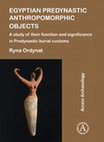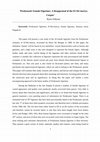Books by Iryna Sharp

'Anne Wagner’s Album (1795-1805): Collecting Feminine Friendship'
Women and the Art and Science of Collecting in Eighteenth-Century Europe, Arlene Leis, Kacie L. Wills (eds), 2020
Through both longer essays and shorter case studies, this book examines the relationship of Europ... more Through both longer essays and shorter case studies, this book examines the relationship of European women from various countries and backgrounds to collecting, in order to explore the social practices and material and visual cultures of collecting in eighteenth-century Europe.
It recovers their lives and examines their interests, their methodologies, and their collections and objects—some of which have rarely been studied before. The book also considers women’s role as producers, that is, creators of objects that were collected. Detailed examination of the artefacts—both visually, and in relation to their historical contexts—exposes new ways of thinking about collecting in relation to the arts and sciences in eighteenth-century Europe. The book is interdisciplinary in its makeup and brings together scholars from a wide range of fields.
It will be of interest to those working in art history, material and visual culture, history of collecting, history of science, literary studies, women’s studies, gender studies, and art conservation.

Anthropomorphic objects from the Egyptian Predynastic have been a topic of frequent study and deb... more Anthropomorphic objects from the Egyptian Predynastic have been a topic of frequent study and debate, from the time they were first excavated until today. These objects, including human figurines, hippopotamus tusks, tag amulets and combs carved with the human image, continue to fascinate and perplex scholars today. Objects such as these form part of the extensive and distinctive iconographic imagery of Predynastic Egypt, and are often interpreted solely in the context of their symbolic or iconographic significance.
The aim of this study is to examine these anthropomorphic objects in terms of their original context in order to determine what role they played in Predynastic burials – a useful method, as most of these objects are found in graves. A database comprising all provenanced anthropomorphic Predynastic objects and their placement in the grave, in addition to the details of each grave, has been composed in order to conduct a detailed analysis. The analysis is geared to answer the question of whether it is possible to determine the function of these objects from the available data, and if so, what the results could tell us about burial practices and rituals in Predynastic Egypt.
It became clear from the results that the context, especially the specific placement of the object in the grave, can reflect significantly the meaning and function of anthropomorphic objects. The placement and function seems to have depended on the type of object: for instance, figurines had different placements and meanings to tusks and tags. Ultimately, it appears that anthropomorphic objects, especially figurines, were personal items with which the deceased were identified and buried by their relations and friends. They may have served as magical or protective items, or as representations of ancestors or the deceased individuals themselves. This conclusion is significant, as it confirms the previous assumptions about the functions of anthropomorphic objects in Predynastic graves through a thorough analysis of available data, making a contribution to our understanding of Predynastic burial rituals.
Papers by Iryna Sharp
Anne Wagner’s Album (1795–1805)
Women and the Art and Science of Collecting in Eighteenth-Century Europe

Ancient Cultures at Monash University Conference
" A group of terracotta female figurines of an unusual style were discovered by Henri De Morgan ... more " A group of terracotta female figurines of an unusual style were discovered by Henri De Morgan during an excavation of an ancient Egyptian Predynastic cemetery at El-Ma’mariya in 1908 and dated to the late Naqada I or early Naqada II period. Among these figurines is the well-known and widely published ‘bird lady’ figurine, now located on display at the Brooklyn Museum, New York. Its arms are raised in a graceful arc upwards – a body pose unique to excavated Predynastic figurines that has nonetheless appeared on Predynastic painted pottery and rock art. Many interpretations have been put forward addressing this specific arm position and its significance to Predynastic culture and religion. The El-Ma’mariya raised arm figurine always features prominently in such interpretations and theories, yet not much has been said of its origins, and there has been no discussion of the rest of the figurine collection unearthed by De Morgan.
The aim of this paper is to discuss the excavation and context of the El-Ma’mariya group of figurines and utilize comparative material, such as Predynastic painted pottery. The paper will then critically examine the various interpretations that have been proposed of the raised arm figurines and consider the significance of depictions of figures with raised arms as opposed to other arm positions and gestures that have appeared elsewhere in Predynastic sculpture and art. The final aim of this paper is to raise awareness of the exaggerated focus on raised arms in Predynastic studies and to bring attention to other, less acknowledged depictions that appear to be just as significant in Predynastic art, but which have not been given much attention. "
Conference Presentations by Iryna Sharp

‘Anne Wagner’s Album (1975-1805): Creating Feminine Visual Culture’
Australian and New Zealand Association for Medieval and Early Modern Studies 12th Biennial Conference, 5th – 8th February, 2019
The album was a popular medium evolved in to late eighteenth and early nineteenth century into a ... more The album was a popular medium evolved in to late eighteenth and early nineteenth century into a practice of keeping a book of collected poetry, drawings, etchings, prints, sketches, autographs, botanical specimens, music and keepsakes, sometimes over many years, or even decades. Such albums would have an author, a compiler or collector, who would curate it, but many, if not most, of the items in an album would be contributed by this author’s family, friends and connections. Albums such as these have rarely been examined by historians, due to the low status and insignificance which has hitherto often been the lot of women’s amateur art .
Using the album of Anne Wagner, digitized by the NY Public Library, this paper will argue against such interpretations by demonstrating how much women’s album have to offer historians in the many new and unique insights and glimpses into intimate family and feminine visual culture of the time. The paper will particularly explore how families and individuals involved in the creation of albums like these are consuming each other’s production, and what this exchange of produced material of sketches, drawings, prints, verses, collages, keepsakes and memorandums shows us about the construction and development of family relationships. This paper will argue that the anonymity of feminine art, when placed in the context of album making, did not signify its low status or low value at all to those who made, gifted, exchanged and circulated this art within their family circle. On the contrary, this paper will show that women must have believed that their experiences and values were worth representing and commemorating in albums , and that a sketch, carefully and lovingly pasted into a family album, along with other examples done by family members and friends, shows how valued and cherished such artworks were in context of family, for which they were produced.

‘The Sutherland Album (1810-1830): Family Exchange of Amateur Art, Memory and Sentiment’
British Society of Eighteenth Century Studies 48th Annual Conference: ‘Islands and Isolation’, 4th - 6th January, 2019
The ‘album’ is a particular type of object which had its beginnings in the Renaissance, and had a... more The ‘album’ is a particular type of object which had its beginnings in the Renaissance, and had also been used from the mid-seventeenth century to describe blank books which visitors in country houses would leave comments in the form of a signature or a short piece of writing. The album evolved in to late eighteenth and early nineteenth century into a practice of keeping a book of collected poetry, drawings, etchings, prints, sketches, autographs, botanical specimens, music and keepsakes, sometimes over many years, or even decades. Such albums would have an author, a compiler or collector, who would curate it, but many, if not most, of the items in an album would be contributed by this author’s family, friends and connections.
The recently digitized Sutherland Album is held in the Victoria and Albert Museum. The owner and compiler of the Sutherland Album is unknown – there is no clear signature or claim to ownership in the album. The only clue appears on the front cover, which is sighed ‘M Rutland’, which could stand for Manners-Rutland, one of the prominent aristocratic English families.
The ‘cult of sensibility’ concerned with displaying and promoting feeling, melancholy and refined emotionalism, was a widespread phenomenon and had a lasting influence on the culture but society of late eighteenth century Britain. This paper will explore what the functions and meanings of the Sutherland Album were, and how more casual and intimate genres of media and material culture, such as the album, were influenced by and perpetuated the popular cultural phenomena of sensibility and feeling. The culture of sensibility had a major influence on the family in encouraging a more openly expressive and emotional involvement in family relationships. This paper will demonstrate how this influence is evidently displayed, though not always overtly, in the Sutherland Album, and can be seen in a range of sentimentalized personal and domestic items, including sketches and verses, which appear in the Sutherland Album, either produced by the family as originals, or reproduced via copy or imitation.
The idea of the companionate or ‘sentimental family’, which extended from romantic ideal of a companionate and compassionate marriage which became popular in the eighteenth century, is often strongly articulated and constructed in the Sutherland Album. The paper will explore this certain created sense of closeness, sentimentality and sensibility that is created and felt in the personal family events recorded in the Sutherland Album, such as births and deaths, commemorated in collected verses, and assembled to very touchingly convey the sentimental value and attachment placed on this very personal items, as a means of remembering.

‘Rediscovering Records: The AUV Archives and Heritage Project at the Ukrainian House, Essendon’
Since its establishment in 1949, the Association of Ukrainians in Victoria has been growing in si... more Since its establishment in 1949, the Association of Ukrainians in Victoria has been growing in size and importance, and has accumulated a large collection of documents, papers and objects reflective of its history and development over the years.
Among those multitudes of documents, currently stored haphazardly in boxes under the performance stage in the AUV headquarters at the Ukrainian House in Essendon, are records, such as receipts, meeting minutes, and member’s lists. But there are also memorandums, photographs, and even costumes, dating back to the early 1960’s, among many other kinds of historical data and objects. Here are buried stories and memories that could help us better understand the achievements of the early and subsequent Ukrainian immigrants, who helped build a supportive community in Victoria.
Historical archiving - the proper recording, cataloguing, filing, storing and sharing of historical documents - is important. Far too often, we hear of collections and archives that are neglected or completely lost, which could have been a valuable resource for future generations. This is why myself, and several other keen volunteers, have decided to embark on an exciting project of archiving the AUV records.
In this paper, I will discuss the progress and results of the project, and use it as a case study to demonstrate the importance of archiving records, and the value of this practice, if employed by local communities not limited to the Association of Ukrainians in Victoria, for understanding and preserving our history.

‘Building Identities from Scraps: How Should We Interpret 19th Century Australian Scrapbooks?’
The status of scrapbooks as legitimate historical material has been found to be ambiguous and pro... more The status of scrapbooks as legitimate historical material has been found to be ambiguous and problematic by those who have made the attempt to analyse and interpret them. A popular Victorian pastime of collecting a plethora of scraps of materials in one or several books (in the guise of diaries and notebooks, but also as collections of family memorabilia and history, sketchbooks, photo albums and songbooks) seemed to have played a much greater and more personal role then has been previously assumed, especially in the daily life or lives of the people who composed them.
Scrapbooks have been the subject of some previous studies focusing on America, and, to some extent, Britain. And many Australian libraries, museums and archives contain a large amount of these wonderful cultural artefacts in their collections, and yet they have been given very little attention by Australian researchers.
Using these previous studies as well as Australian scrapbook examples, including those made by the artist Georgiana McCrae and her granddaughter, the poetess Dorothy Frances McCrae (later Perry), I will give an overall introduction to 19th century scrapbook material in Australia and inquire into the nature of interpretations that can be made of this fascinating practice. My intention is to examine the variety of scrapbooks as well as the variety of people who made them, and to understand how each individual used and altered the scrapbooking method to fit their own needs and purposes. I will also examine scrapbooks as a communal and collective practice, and understand what things these objects can tell us about how groups of people communicated and engaged with each other through scrapbooking.
Intention or Accident? Discussion of Deliberate Breakage of Human Figurines in Predynastic Burials

This presentation will examine a wide range of objects from the Predynastic period, predominantly... more This presentation will examine a wide range of objects from the Predynastic period, predominantly either excavated in burials or purchased by early excavators. It will focus specifically on those objects which bear the human image, or which are carved to resemble a human form. These include hippopotamus carved tusks, tags (pendants with a grooved edge intended for a leather strap) and human figurines encompassing the Badarian period to late Naqada III, but with the majority dating to the Naqada I and Naqada II periods. These objects were of obvious significance in the life as well as in death of the Predynastic Egyptians, and had served particular functions in their social and religious practices. They are also some of the most commonly found objects in Upper Egypt, and come from a variety of sites in the region.
The aim of this presentation is to define the criteria for identifying the sex depicted in these objects. It will attempt to analyse different features of tusks, tags and figurines and to compose a possible guideline for assigning sex to the image. These features include beards, breasts and genitalia, decoration and adornment, waist to hip ratio and facial features and the shape and form of the object itself. In studying and comparing the tusks, tags and figurines together, rather than in separate groups, some new light may be shed on the ways Predynastic peoples may have identified and depicted gender, and what importance they may have assigned to it. The presentation will seek to review the current evidence available and in its conclusion, will seek to make a contribution to the study and current understanding of the significance of early Egypt’s art and iconography.
Thesis by Iryna Sharp

Egyptian Predynastic Anthropomorphic Objects: A Study of Their Function and Significance in Predynastic Burial Customs (MA Thesis, Monash University, 2016)
Anthropomorphic objects from the Egyptian Predynastic have been a topic of frequent study and deb... more Anthropomorphic objects from the Egyptian Predynastic have been a topic of frequent study and debate, from the time they were first excavated until today. These objects, including human figurines, hippopotamus tusks, tag amulets and combs carved with the human image, continue to fascinate and perplex scholars today. Objects such as these form part of the extensive and distinctive iconographic imagery of Predynastic Egypt, and are often interpreted solely in the context of their symbolic or iconographic significance.
The aim of this thesis is to examine these anthropomorphic objects in terms of their original context in order to determine what role they played in Predynastic burials – a useful method, as most of these objects are found in graves. A database comprising all provenanced anthropomorphic Predynastic objects and their placement in the grave, in addition to the details of each grave, has been composed in order to conduct a detailed analysis. The analysis is geared to answer the question of whether it is possible to determine the function of these objects from the available data, and if so, what the results could tell us about burial practices and rituals in Predynastic Egypt.
It became clear from the results that the context, especially the specific placement of the object in the grave, can reflect significantly the meaning and function of anthropomorphic objects. The placement and function seems to have depended on the type of object: for instance, figurines had different placements and meanings to tusks and tags.
Ultimately, it appears that anthropomorphic objects, especially figurines, were personal items with which the deceased were identified and buried by their relations and friends. They may have served as magical or protective items, or as representations of ancestors or the deceased individuals themselves. This conclusion is significant, as it confirms the previous assumptions about the functions of anthropomorphic objects in Predynastic graves through a thorough analysis of available data, making a contribution to our understanding of Predynastic burial rituals.











Uploads
Books by Iryna Sharp
It recovers their lives and examines their interests, their methodologies, and their collections and objects—some of which have rarely been studied before. The book also considers women’s role as producers, that is, creators of objects that were collected. Detailed examination of the artefacts—both visually, and in relation to their historical contexts—exposes new ways of thinking about collecting in relation to the arts and sciences in eighteenth-century Europe. The book is interdisciplinary in its makeup and brings together scholars from a wide range of fields.
It will be of interest to those working in art history, material and visual culture, history of collecting, history of science, literary studies, women’s studies, gender studies, and art conservation.
The aim of this study is to examine these anthropomorphic objects in terms of their original context in order to determine what role they played in Predynastic burials – a useful method, as most of these objects are found in graves. A database comprising all provenanced anthropomorphic Predynastic objects and their placement in the grave, in addition to the details of each grave, has been composed in order to conduct a detailed analysis. The analysis is geared to answer the question of whether it is possible to determine the function of these objects from the available data, and if so, what the results could tell us about burial practices and rituals in Predynastic Egypt.
It became clear from the results that the context, especially the specific placement of the object in the grave, can reflect significantly the meaning and function of anthropomorphic objects. The placement and function seems to have depended on the type of object: for instance, figurines had different placements and meanings to tusks and tags. Ultimately, it appears that anthropomorphic objects, especially figurines, were personal items with which the deceased were identified and buried by their relations and friends. They may have served as magical or protective items, or as representations of ancestors or the deceased individuals themselves. This conclusion is significant, as it confirms the previous assumptions about the functions of anthropomorphic objects in Predynastic graves through a thorough analysis of available data, making a contribution to our understanding of Predynastic burial rituals.
Papers by Iryna Sharp
The aim of this paper is to discuss the excavation and context of the El-Ma’mariya group of figurines and utilize comparative material, such as Predynastic painted pottery. The paper will then critically examine the various interpretations that have been proposed of the raised arm figurines and consider the significance of depictions of figures with raised arms as opposed to other arm positions and gestures that have appeared elsewhere in Predynastic sculpture and art. The final aim of this paper is to raise awareness of the exaggerated focus on raised arms in Predynastic studies and to bring attention to other, less acknowledged depictions that appear to be just as significant in Predynastic art, but which have not been given much attention. "
Conference Presentations by Iryna Sharp
Using the album of Anne Wagner, digitized by the NY Public Library, this paper will argue against such interpretations by demonstrating how much women’s album have to offer historians in the many new and unique insights and glimpses into intimate family and feminine visual culture of the time. The paper will particularly explore how families and individuals involved in the creation of albums like these are consuming each other’s production, and what this exchange of produced material of sketches, drawings, prints, verses, collages, keepsakes and memorandums shows us about the construction and development of family relationships. This paper will argue that the anonymity of feminine art, when placed in the context of album making, did not signify its low status or low value at all to those who made, gifted, exchanged and circulated this art within their family circle. On the contrary, this paper will show that women must have believed that their experiences and values were worth representing and commemorating in albums , and that a sketch, carefully and lovingly pasted into a family album, along with other examples done by family members and friends, shows how valued and cherished such artworks were in context of family, for which they were produced.
The recently digitized Sutherland Album is held in the Victoria and Albert Museum. The owner and compiler of the Sutherland Album is unknown – there is no clear signature or claim to ownership in the album. The only clue appears on the front cover, which is sighed ‘M Rutland’, which could stand for Manners-Rutland, one of the prominent aristocratic English families.
The ‘cult of sensibility’ concerned with displaying and promoting feeling, melancholy and refined emotionalism, was a widespread phenomenon and had a lasting influence on the culture but society of late eighteenth century Britain. This paper will explore what the functions and meanings of the Sutherland Album were, and how more casual and intimate genres of media and material culture, such as the album, were influenced by and perpetuated the popular cultural phenomena of sensibility and feeling. The culture of sensibility had a major influence on the family in encouraging a more openly expressive and emotional involvement in family relationships. This paper will demonstrate how this influence is evidently displayed, though not always overtly, in the Sutherland Album, and can be seen in a range of sentimentalized personal and domestic items, including sketches and verses, which appear in the Sutherland Album, either produced by the family as originals, or reproduced via copy or imitation.
The idea of the companionate or ‘sentimental family’, which extended from romantic ideal of a companionate and compassionate marriage which became popular in the eighteenth century, is often strongly articulated and constructed in the Sutherland Album. The paper will explore this certain created sense of closeness, sentimentality and sensibility that is created and felt in the personal family events recorded in the Sutherland Album, such as births and deaths, commemorated in collected verses, and assembled to very touchingly convey the sentimental value and attachment placed on this very personal items, as a means of remembering.
Among those multitudes of documents, currently stored haphazardly in boxes under the performance stage in the AUV headquarters at the Ukrainian House in Essendon, are records, such as receipts, meeting minutes, and member’s lists. But there are also memorandums, photographs, and even costumes, dating back to the early 1960’s, among many other kinds of historical data and objects. Here are buried stories and memories that could help us better understand the achievements of the early and subsequent Ukrainian immigrants, who helped build a supportive community in Victoria.
Historical archiving - the proper recording, cataloguing, filing, storing and sharing of historical documents - is important. Far too often, we hear of collections and archives that are neglected or completely lost, which could have been a valuable resource for future generations. This is why myself, and several other keen volunteers, have decided to embark on an exciting project of archiving the AUV records.
In this paper, I will discuss the progress and results of the project, and use it as a case study to demonstrate the importance of archiving records, and the value of this practice, if employed by local communities not limited to the Association of Ukrainians in Victoria, for understanding and preserving our history.
Scrapbooks have been the subject of some previous studies focusing on America, and, to some extent, Britain. And many Australian libraries, museums and archives contain a large amount of these wonderful cultural artefacts in their collections, and yet they have been given very little attention by Australian researchers.
Using these previous studies as well as Australian scrapbook examples, including those made by the artist Georgiana McCrae and her granddaughter, the poetess Dorothy Frances McCrae (later Perry), I will give an overall introduction to 19th century scrapbook material in Australia and inquire into the nature of interpretations that can be made of this fascinating practice. My intention is to examine the variety of scrapbooks as well as the variety of people who made them, and to understand how each individual used and altered the scrapbooking method to fit their own needs and purposes. I will also examine scrapbooks as a communal and collective practice, and understand what things these objects can tell us about how groups of people communicated and engaged with each other through scrapbooking.
The aim of this presentation is to define the criteria for identifying the sex depicted in these objects. It will attempt to analyse different features of tusks, tags and figurines and to compose a possible guideline for assigning sex to the image. These features include beards, breasts and genitalia, decoration and adornment, waist to hip ratio and facial features and the shape and form of the object itself. In studying and comparing the tusks, tags and figurines together, rather than in separate groups, some new light may be shed on the ways Predynastic peoples may have identified and depicted gender, and what importance they may have assigned to it. The presentation will seek to review the current evidence available and in its conclusion, will seek to make a contribution to the study and current understanding of the significance of early Egypt’s art and iconography.
Thesis by Iryna Sharp
The aim of this thesis is to examine these anthropomorphic objects in terms of their original context in order to determine what role they played in Predynastic burials – a useful method, as most of these objects are found in graves. A database comprising all provenanced anthropomorphic Predynastic objects and their placement in the grave, in addition to the details of each grave, has been composed in order to conduct a detailed analysis. The analysis is geared to answer the question of whether it is possible to determine the function of these objects from the available data, and if so, what the results could tell us about burial practices and rituals in Predynastic Egypt.
It became clear from the results that the context, especially the specific placement of the object in the grave, can reflect significantly the meaning and function of anthropomorphic objects. The placement and function seems to have depended on the type of object: for instance, figurines had different placements and meanings to tusks and tags.
Ultimately, it appears that anthropomorphic objects, especially figurines, were personal items with which the deceased were identified and buried by their relations and friends. They may have served as magical or protective items, or as representations of ancestors or the deceased individuals themselves. This conclusion is significant, as it confirms the previous assumptions about the functions of anthropomorphic objects in Predynastic graves through a thorough analysis of available data, making a contribution to our understanding of Predynastic burial rituals.
It recovers their lives and examines their interests, their methodologies, and their collections and objects—some of which have rarely been studied before. The book also considers women’s role as producers, that is, creators of objects that were collected. Detailed examination of the artefacts—both visually, and in relation to their historical contexts—exposes new ways of thinking about collecting in relation to the arts and sciences in eighteenth-century Europe. The book is interdisciplinary in its makeup and brings together scholars from a wide range of fields.
It will be of interest to those working in art history, material and visual culture, history of collecting, history of science, literary studies, women’s studies, gender studies, and art conservation.
The aim of this study is to examine these anthropomorphic objects in terms of their original context in order to determine what role they played in Predynastic burials – a useful method, as most of these objects are found in graves. A database comprising all provenanced anthropomorphic Predynastic objects and their placement in the grave, in addition to the details of each grave, has been composed in order to conduct a detailed analysis. The analysis is geared to answer the question of whether it is possible to determine the function of these objects from the available data, and if so, what the results could tell us about burial practices and rituals in Predynastic Egypt.
It became clear from the results that the context, especially the specific placement of the object in the grave, can reflect significantly the meaning and function of anthropomorphic objects. The placement and function seems to have depended on the type of object: for instance, figurines had different placements and meanings to tusks and tags. Ultimately, it appears that anthropomorphic objects, especially figurines, were personal items with which the deceased were identified and buried by their relations and friends. They may have served as magical or protective items, or as representations of ancestors or the deceased individuals themselves. This conclusion is significant, as it confirms the previous assumptions about the functions of anthropomorphic objects in Predynastic graves through a thorough analysis of available data, making a contribution to our understanding of Predynastic burial rituals.
The aim of this paper is to discuss the excavation and context of the El-Ma’mariya group of figurines and utilize comparative material, such as Predynastic painted pottery. The paper will then critically examine the various interpretations that have been proposed of the raised arm figurines and consider the significance of depictions of figures with raised arms as opposed to other arm positions and gestures that have appeared elsewhere in Predynastic sculpture and art. The final aim of this paper is to raise awareness of the exaggerated focus on raised arms in Predynastic studies and to bring attention to other, less acknowledged depictions that appear to be just as significant in Predynastic art, but which have not been given much attention. "
Using the album of Anne Wagner, digitized by the NY Public Library, this paper will argue against such interpretations by demonstrating how much women’s album have to offer historians in the many new and unique insights and glimpses into intimate family and feminine visual culture of the time. The paper will particularly explore how families and individuals involved in the creation of albums like these are consuming each other’s production, and what this exchange of produced material of sketches, drawings, prints, verses, collages, keepsakes and memorandums shows us about the construction and development of family relationships. This paper will argue that the anonymity of feminine art, when placed in the context of album making, did not signify its low status or low value at all to those who made, gifted, exchanged and circulated this art within their family circle. On the contrary, this paper will show that women must have believed that their experiences and values were worth representing and commemorating in albums , and that a sketch, carefully and lovingly pasted into a family album, along with other examples done by family members and friends, shows how valued and cherished such artworks were in context of family, for which they were produced.
The recently digitized Sutherland Album is held in the Victoria and Albert Museum. The owner and compiler of the Sutherland Album is unknown – there is no clear signature or claim to ownership in the album. The only clue appears on the front cover, which is sighed ‘M Rutland’, which could stand for Manners-Rutland, one of the prominent aristocratic English families.
The ‘cult of sensibility’ concerned with displaying and promoting feeling, melancholy and refined emotionalism, was a widespread phenomenon and had a lasting influence on the culture but society of late eighteenth century Britain. This paper will explore what the functions and meanings of the Sutherland Album were, and how more casual and intimate genres of media and material culture, such as the album, were influenced by and perpetuated the popular cultural phenomena of sensibility and feeling. The culture of sensibility had a major influence on the family in encouraging a more openly expressive and emotional involvement in family relationships. This paper will demonstrate how this influence is evidently displayed, though not always overtly, in the Sutherland Album, and can be seen in a range of sentimentalized personal and domestic items, including sketches and verses, which appear in the Sutherland Album, either produced by the family as originals, or reproduced via copy or imitation.
The idea of the companionate or ‘sentimental family’, which extended from romantic ideal of a companionate and compassionate marriage which became popular in the eighteenth century, is often strongly articulated and constructed in the Sutherland Album. The paper will explore this certain created sense of closeness, sentimentality and sensibility that is created and felt in the personal family events recorded in the Sutherland Album, such as births and deaths, commemorated in collected verses, and assembled to very touchingly convey the sentimental value and attachment placed on this very personal items, as a means of remembering.
Among those multitudes of documents, currently stored haphazardly in boxes under the performance stage in the AUV headquarters at the Ukrainian House in Essendon, are records, such as receipts, meeting minutes, and member’s lists. But there are also memorandums, photographs, and even costumes, dating back to the early 1960’s, among many other kinds of historical data and objects. Here are buried stories and memories that could help us better understand the achievements of the early and subsequent Ukrainian immigrants, who helped build a supportive community in Victoria.
Historical archiving - the proper recording, cataloguing, filing, storing and sharing of historical documents - is important. Far too often, we hear of collections and archives that are neglected or completely lost, which could have been a valuable resource for future generations. This is why myself, and several other keen volunteers, have decided to embark on an exciting project of archiving the AUV records.
In this paper, I will discuss the progress and results of the project, and use it as a case study to demonstrate the importance of archiving records, and the value of this practice, if employed by local communities not limited to the Association of Ukrainians in Victoria, for understanding and preserving our history.
Scrapbooks have been the subject of some previous studies focusing on America, and, to some extent, Britain. And many Australian libraries, museums and archives contain a large amount of these wonderful cultural artefacts in their collections, and yet they have been given very little attention by Australian researchers.
Using these previous studies as well as Australian scrapbook examples, including those made by the artist Georgiana McCrae and her granddaughter, the poetess Dorothy Frances McCrae (later Perry), I will give an overall introduction to 19th century scrapbook material in Australia and inquire into the nature of interpretations that can be made of this fascinating practice. My intention is to examine the variety of scrapbooks as well as the variety of people who made them, and to understand how each individual used and altered the scrapbooking method to fit their own needs and purposes. I will also examine scrapbooks as a communal and collective practice, and understand what things these objects can tell us about how groups of people communicated and engaged with each other through scrapbooking.
The aim of this presentation is to define the criteria for identifying the sex depicted in these objects. It will attempt to analyse different features of tusks, tags and figurines and to compose a possible guideline for assigning sex to the image. These features include beards, breasts and genitalia, decoration and adornment, waist to hip ratio and facial features and the shape and form of the object itself. In studying and comparing the tusks, tags and figurines together, rather than in separate groups, some new light may be shed on the ways Predynastic peoples may have identified and depicted gender, and what importance they may have assigned to it. The presentation will seek to review the current evidence available and in its conclusion, will seek to make a contribution to the study and current understanding of the significance of early Egypt’s art and iconography.
The aim of this thesis is to examine these anthropomorphic objects in terms of their original context in order to determine what role they played in Predynastic burials – a useful method, as most of these objects are found in graves. A database comprising all provenanced anthropomorphic Predynastic objects and their placement in the grave, in addition to the details of each grave, has been composed in order to conduct a detailed analysis. The analysis is geared to answer the question of whether it is possible to determine the function of these objects from the available data, and if so, what the results could tell us about burial practices and rituals in Predynastic Egypt.
It became clear from the results that the context, especially the specific placement of the object in the grave, can reflect significantly the meaning and function of anthropomorphic objects. The placement and function seems to have depended on the type of object: for instance, figurines had different placements and meanings to tusks and tags.
Ultimately, it appears that anthropomorphic objects, especially figurines, were personal items with which the deceased were identified and buried by their relations and friends. They may have served as magical or protective items, or as representations of ancestors or the deceased individuals themselves. This conclusion is significant, as it confirms the previous assumptions about the functions of anthropomorphic objects in Predynastic graves through a thorough analysis of available data, making a contribution to our understanding of Predynastic burial rituals.